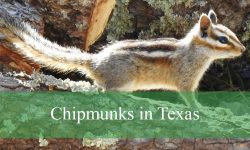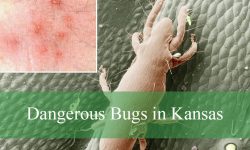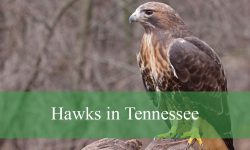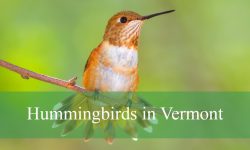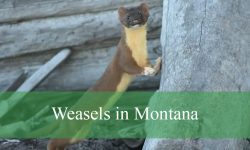If you’re curious about the diverse types of caterpillars in Texas, you’re in the right place. Texas is home to a wide variety of caterpillar species, each with unique colors, shapes, and behaviors. Understanding these fascinating insects can enhance your appreciation of the natural world and help with identification whether you’re a gardener, nature enthusiast, or educator.
Caterpillars in Texas play an important role in the ecosystem, serving as both pollinators and a vital food source for birds and other wildlife. From the striking Monarch Caterpillar to the unusual Saddleback Caterpillar, the range of species reflects the state’s diverse habitats—from forests and grasslands to urban gardens. Knowing how to recognize these caterpillars can also help protect your plants and encourage beneficial species.
In this guide, we’ll explore 56 common types of caterpillars in Texas, complete with pictures and identification tips. Whether you want to learn about their appearance, behavior, or host plants, this comprehensive list will help you spot and understand the incredible caterpillars you might encounter across the Lone Star State.
Different Types of Caterpillars in Texas
Monarch Caterpillar (Danaus plexippus)

The Monarch caterpillar is one of the most recognizable larvae in North America, including throughout Texas. It features bold black, white, and yellow stripes that run the length of its elongated, cylindrical body. It typically grows to about 2 inches long before pupating. One of its most distinguishing features is the presence of two pairs of black filaments—one pair near the head and one near the tail.
This caterpillar feeds exclusively on milkweed species (genus Asclepias), which provide the toxins that make both the larva and adult butterfly unpalatable to predators. Monarch caterpillars can often be found crawling on milkweed plants in fields, prairies, and even urban gardens, especially during the spring and fall migrations. Their feeding behavior is methodical, often stripping leaves entirely before moving to the next.
In Texas, Monarch caterpillars are widespread, particularly in central and southern regions during migration seasons. Texas serves as a crucial stopover and breeding ground during the butterflies’ north-south journeys. The caterpillars’ development time depends on temperature but typically spans around 10 to 14 days before forming a jade green chrysalis with golden spots.
Black Swallowtail Caterpillar (Papilio polyxenes)
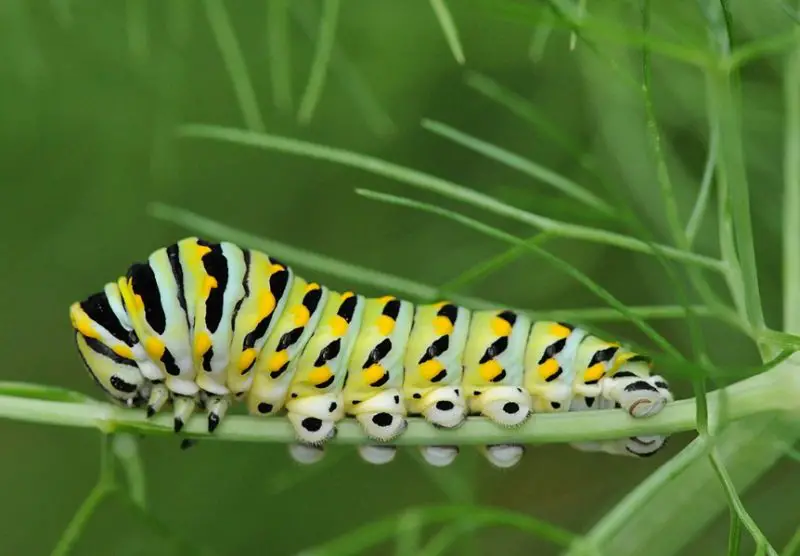
The Black Swallowtail caterpillar is known for its vibrant green body adorned with black bands and yellow dots. As it matures, it undergoes a striking transformation from a spiny, bird-dropping mimic in its early instars to a smooth, colorful caterpillar. At full size, it measures around 1.5 to 2 inches in length and has a plump, segmented appearance.
This caterpillar primarily feeds on members of the carrot family, including parsley, dill, fennel, and Queen Anne’s lace. It is often found in herb gardens or meadows where host plants are plentiful. When threatened, it can extend a bright orange osmeterium—a forked organ behind its head—that emits a foul smell to deter predators.
In Texas, the Black Swallowtail is found in both rural and urban environments, especially in areas with open fields and garden plots. It is most commonly seen from spring through early fall. The species thrives across the eastern and central parts of the state, with multiple broods occurring each year in warmer climates.
Gulf Fritillary Caterpillar (Dione vanillae)
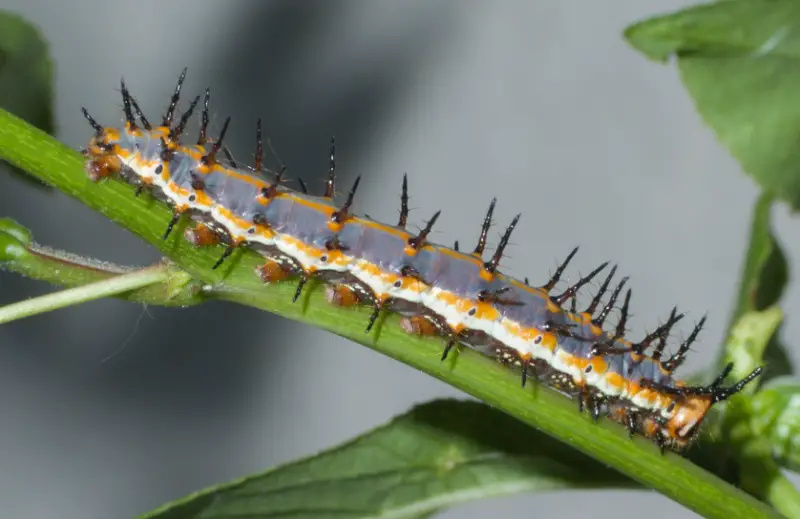
The Gulf Fritillary caterpillar is strikingly colored, with a reddish-orange body covered in rows of black spines. Despite its fierce appearance, the spines are not dangerous to humans but serve as a deterrent to potential predators. Its body may also display faint black lines or dots along the sides.
This caterpillar feeds almost exclusively on passionflower vines (Passiflora spp.), making it a frequent visitor to gardens and wild areas where these plants grow. It is active and voracious, often defoliating host vines in large numbers. The caterpillars are usually solitary and can be found on both cultivated and wild passionflowers.
In Texas, Gulf Fritillary caterpillars are especially abundant in the southern and coastal regions, where their host plants flourish. They are active throughout much of the year in warm climates, often producing multiple generations. The caterpillar stage lasts about 10 to 12 days before it forms a brownish chrysalis that mimics a dried leaf.
Painted Lady Caterpillar (Vanessa cardui)
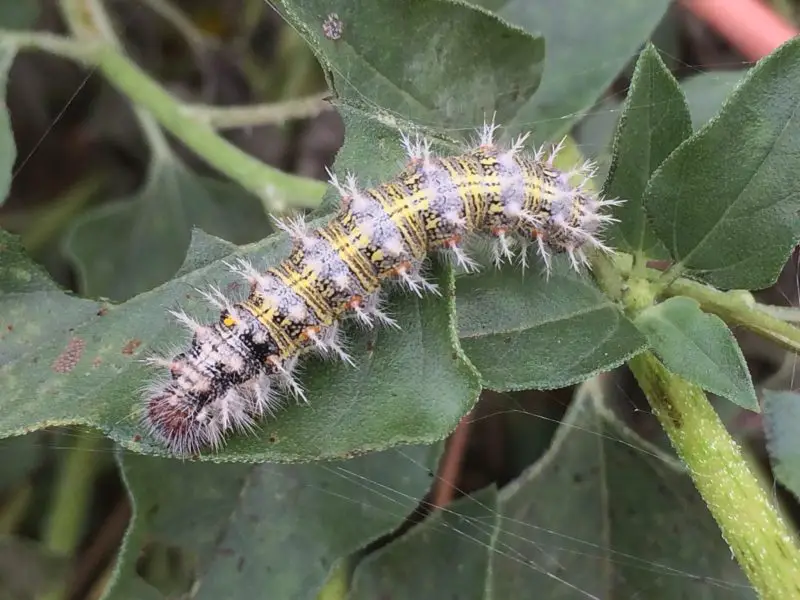
The Painted Lady caterpillar has a spiny, dark-colored body with white or yellow markings, giving it a bristly and rugged look. It often reaches about 1.25 inches in length and may appear grayish-black or brown depending on its age and lighting. Tiny pale spots can sometimes be seen along the sides of its segments.
It feeds on a wide variety of host plants, including thistles, mallows, hollyhocks, and legumes. These caterpillars are known for constructing loose silk shelters by folding leaves together, where they remain hidden during most of the day. They are solitary feeders, rarely seen in large groups except during population booms.
In Texas, Painted Lady caterpillars are common statewide, especially during spring and fall migrations. Their adaptable nature allows them to thrive in prairies, gardens, and disturbed habitats. Their development from egg to chrysalis typically takes two to three weeks, depending on temperature and food availability.
Pipevine Swallowtail Caterpillar (Battus philenor)
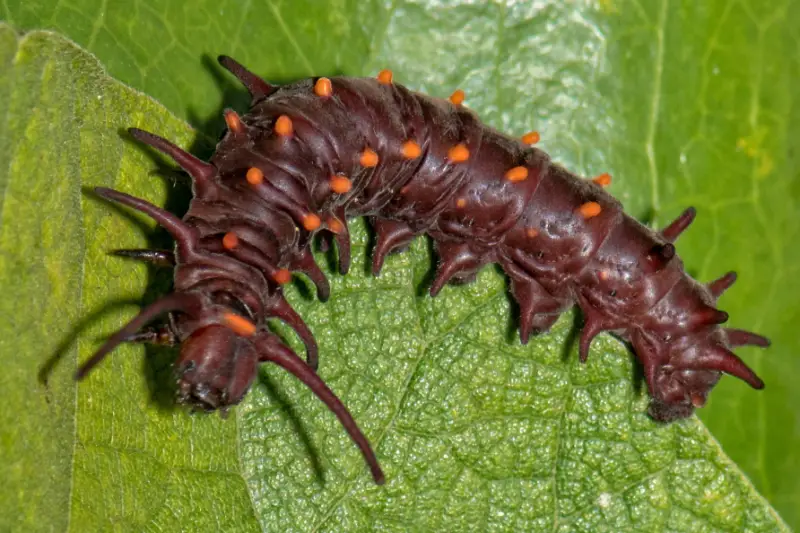
The Pipevine Swallowtail caterpillar is notable for its dark, reddish-brown to black color and numerous fleshy orange or red tubercles (spikes) along its back and sides. It has a soft, velvety appearance and can grow up to 2 inches long. Young caterpillars may be more reddish in color, gradually darkening as they mature.
This species feeds exclusively on pipevine plants (Aristolochia spp.), which contain toxic compounds. These toxins accumulate in the caterpillar’s body, making it distasteful to predators—a trait passed on to the adult butterfly. The caterpillars often cluster together when young but become more solitary as they grow.
In Texas, Pipevine Swallowtail caterpillars are most commonly found in the eastern and southern parts of the state, where pipevines are naturally present or cultivated. They are particularly active from spring through fall, with multiple generations possible in warmer areas. Their pupae can overwinter, allowing them to emerge with favorable conditions in spring.
Queen Caterpillar (Danaus gilippus)
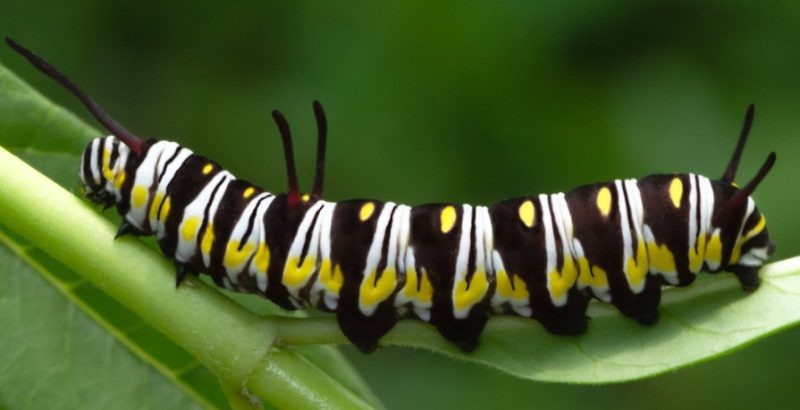
The Queen caterpillar closely resembles the Monarch but can be identified by its additional set of black filaments—three pairs instead of two—and its more vivid white and yellow striping on a black body. It typically reaches about 1.5 to 2 inches in length and has a smooth, plump appearance. The coloration acts as a warning to predators of its toxicity, acquired from its host plants.
This caterpillar primarily feeds on milkweed species, especially Asclepias curassavica and other tropical milkweeds, from which it sequesters toxic compounds called cardenolides. Its feeding behavior is similar to that of the Monarch, and it often coexists with Monarch caterpillars in the same habitat. It tends to feed more heavily on young leaves and may be seen resting under leaves during the heat of the day.
In Texas, the Queen caterpillar is most commonly found in the southern and central parts of the state. It thrives in open fields, roadside habitats, and butterfly gardens planted with milkweed. The caterpillar has multiple broods in warmer months and can be seen well into the fall in areas with mild winters.
Eastern Giant Swallowtail Caterpillar (Papilio cresphontes)

The Eastern Giant Swallowtail caterpillar is often described as looking like bird droppings—a clever disguise to avoid predators. Its mottled brown, white, and cream coloration gives it a camouflaged appearance. When fully grown, it can reach an impressive length of about 2 inches or more, making it one of the largest caterpillars in North America.
This caterpillar feeds on citrus plants and other members of the Rutaceae family, including prickly ash and hoptree. In gardens, they are often found on lemon, lime, and orange trees. When threatened, the caterpillar extends a bright red osmeterium that emits a pungent smell, deterring potential attackers.
In Texas, Eastern Giant Swallowtail caterpillars are widespread, especially in the eastern and southern parts of the state. They are active during spring through fall and often have two to three generations per year. Their large size and unique appearance make them a memorable sight for gardeners and nature enthusiasts alike.
Cloudless Sulphur Caterpillar (Phoebis sennae)
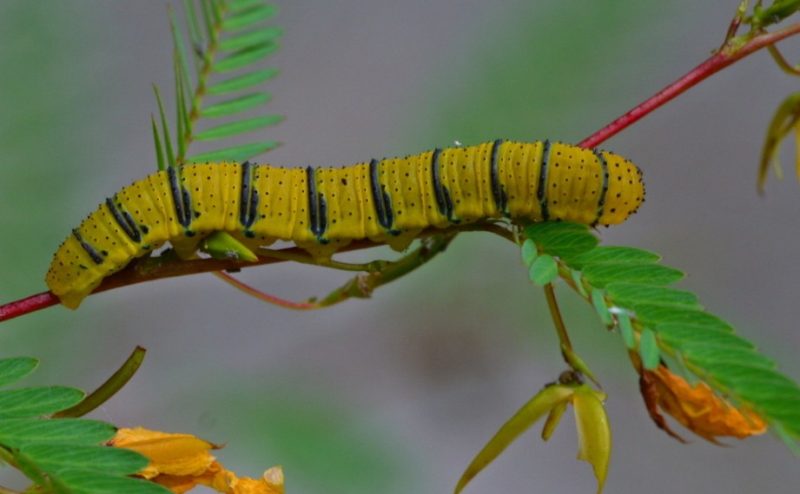
The Cloudless Sulphur caterpillar is typically green with subtle yellow or white stripes running lengthwise down the body. It is slender and smooth, often blending in seamlessly with the foliage of its host plant. In some cases, the caterpillar may appear yellow or partially pink depending on diet and lighting.
This caterpillar feeds on cassia plants (Senna spp.), which are its primary host plants. It is known for its rapid growth and strong appetite, often consuming entire leaflets. The larvae are often found along the stems or under leaves, where they remain well camouflaged and protected from predators.
In Texas, Cloudless Sulphur caterpillars are commonly found throughout the state, especially in the warmer southern regions. They thrive in sunny habitats like gardens, roadsides, and open fields where host plants are abundant. Multiple generations can occur each year, particularly in areas with mild winters.
Eastern Tiger Swallowtail Caterpillar (Papilio glaucus)

The Eastern Tiger Swallowtail caterpillar undergoes several transformations as it matures. Younger instars are dark and resemble bird droppings, while older larvae become bright green with large, false eyespots on the thorax, creating the illusion of a snake’s head to deter predators. The mature caterpillar can grow up to 2 inches long and has a smooth, thick body.
It feeds on a wide variety of host plants including wild cherry, tulip tree, ash, and birch. The caterpillars are usually solitary and well-hidden on the upper surfaces of leaves. When threatened, they extend an orange osmeterium that emits a strong odor to ward off predators.
In Texas, the Eastern Tiger Swallowtail caterpillar is more frequently observed in the eastern part of the state, especially in wooded areas, river valleys, and parks. It is active from spring through late summer and may produce two broods per year. The species is admired for its large size and defensive adaptations.
Fall Webworm (Hyphantria cunea)

The Fall Webworm is a fuzzy white caterpillar with black or reddish heads, depending on the region. It has tufts of long, white hairs emerging from small black tubercles along its body. It grows up to 1 inch long and is typically found in large groups.
This caterpillar is known for its communal web-building behavior. It spins large, silken tents over the ends of tree branches and feeds within these webs. It consumes a wide variety of deciduous tree leaves including pecan, hickory, walnut, persimmon, and many others, making it a generalist feeder.
In Texas, the Fall Webworm is found statewide and is especially prevalent in late summer and early fall. It often draws attention due to the conspicuous webs it constructs on shade trees in both urban and rural settings. While unsightly, it rarely causes lasting damage to healthy, mature trees.
Fall Armyworm (Spodoptera frugiperda)
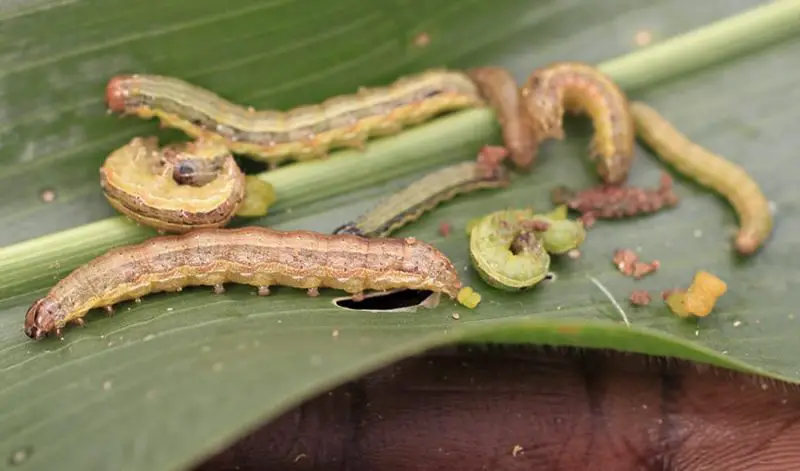
The Fall Armyworm caterpillar is a smooth-bodied larva that varies in color from green to brown or nearly black, often marked with light stripes and a distinctive inverted “Y” on its head capsule. Mature caterpillars grow up to 1.5 inches long and are highly active feeders, capable of causing significant damage in a short time. Their bodies are slightly bristled, and the terminal abdominal segment often shows four distinct dark spots arranged in a square.
These caterpillars feed on a wide range of plants but are especially known for attacking grasses such as corn, sorghum, and turfgrass. They move in large numbers, giving them their “armyworm” name, as they march across fields and lawns consuming vegetation. They typically feed at night and hide during the day in plant debris or soil.
In Texas, Fall Armyworms are most problematic from late summer to early fall, especially after periods of heavy rain. They are widespread across the state and are a major agricultural pest in both rural and suburban landscapes. Due to their migratory nature, infestations can appear rapidly and with little warning.
Polyphemus Moth Caterpillar (Antheraea polyphemus)

The Polyphemus Moth caterpillar is one of the largest native caterpillars in North America, often reaching lengths of up to 4 inches. It is bright green with silver or yellow lateral spots and covered with sparse white hairs. Its bulky appearance is complemented by a slightly wrinkled texture and small dorsal spines.
These caterpillars feed on a wide variety of deciduous trees and shrubs, including oak, maple, birch, and willow. They are solitary feeders and consume large quantities of foliage as they prepare for their transformation into equally massive silk moths. Despite their size, they are generally non-aggressive and easy to observe.
In Texas, Polyphemus Moth caterpillars can be found in wooded areas, suburban gardens, and parks throughout the state. They are more commonly seen in late spring and summer. The cocoon, made of brown silk, is typically attached to a twig or nestled in leaf litter, where the caterpillar pupates through the winter.
Variegated Fritillary Caterpillar (Euptoieta claudia)

The Variegated Fritillary caterpillar is a striking insect with a black body adorned with white stripes and bright orange or red bands. It is also covered with black spines and has a row of orange spots along its sides. Reaching about 1.5 inches in length, it is quite visible when feeding on host plants.
This caterpillar primarily feeds on passionflower (Passiflora spp.), plantain, and violets. It tends to feed openly and individually rather than in groups. Although its spiny appearance may look threatening, it is harmless to humans and does not sting or bite.
In Texas, Variegated Fritillary caterpillars are widely distributed and commonly seen in open fields, gardens, and roadsides. They are active from spring through fall, and multiple broods occur in the warmer months. Their bold coloration and unique host plant preferences make them popular among butterfly gardeners.
Common Buckeye Caterpillar (Junonia coenia)
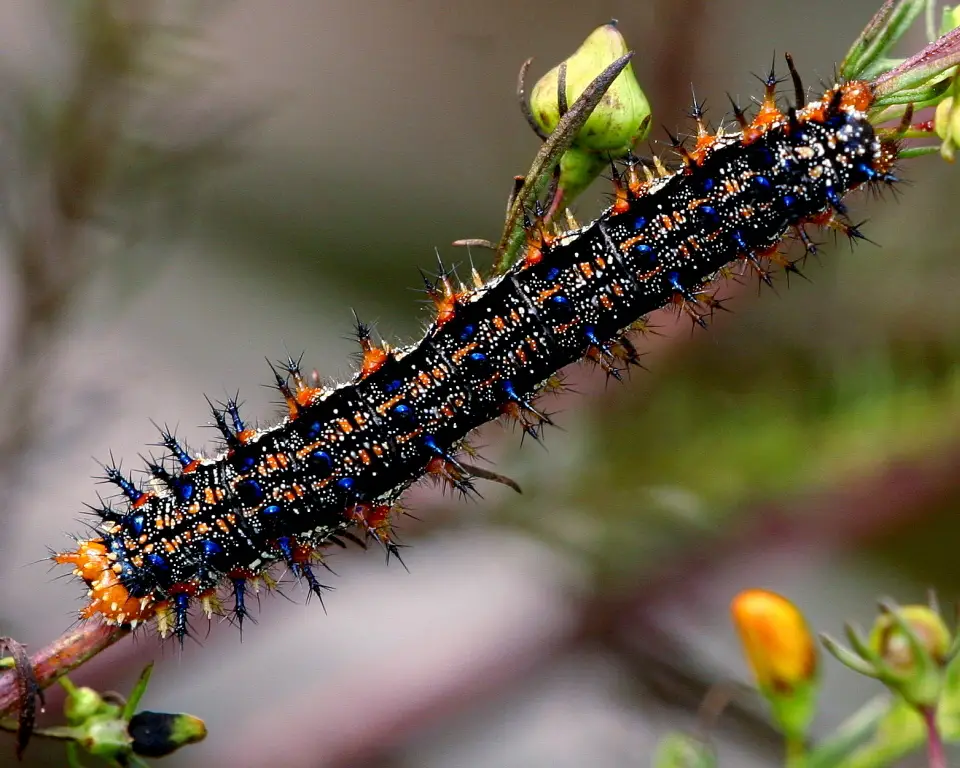
The Common Buckeye caterpillar is dark brown to black with orange bands and white dots along the sides. It is covered in branched spines that give it a somewhat armored appearance. These spines are not harmful to humans but serve as a deterrent to predators. The caterpillar grows up to 1.5 inches long.
It primarily feeds on plants in the snapdragon and plantain families, especially toadflax, plantain, and ruellia. The caterpillar often rests along the midrib of leaves and is typically solitary. Its appearance is somewhat variable depending on the host plant and environmental conditions.
In Texas, the Common Buckeye caterpillar is common in both rural and urban areas, especially in open spaces like fields, pastures, and roadsides. It is active from spring through fall and produces multiple generations in a year. The adult butterfly is also easily recognizable and contributes to the popularity of this species in butterfly gardens.
Gray Hairstreak Caterpillar (Strymon melinus)
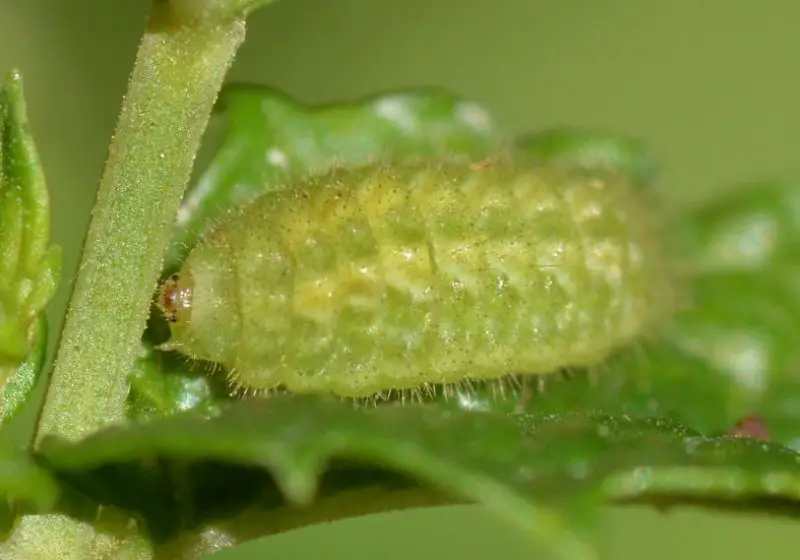
The Gray Hairstreak caterpillar is small, typically about 1 inch in length, and has a slug-like shape. Its body is velvety green or occasionally reddish, depending on diet, with faint diagonal markings and a slightly flattened appearance. It often blends in well with host plants and is difficult to spot.
This species has a diverse diet and feeds on many leguminous plants such as clover, beans, and mallows, as well as cotton and other commercial crops. It is known for its association with ants, which may protect the caterpillar in exchange for sugary secretions from special glands.
In Texas, Gray Hairstreak caterpillars are found throughout the state in gardens, grasslands, and agricultural areas. They are active nearly year-round in southern regions and during warmer months farther north. Their subtle beauty and mutualistic ant relationships make them especially interesting to observe.
Red Admiral Caterpillar (Vanessa atalanta)
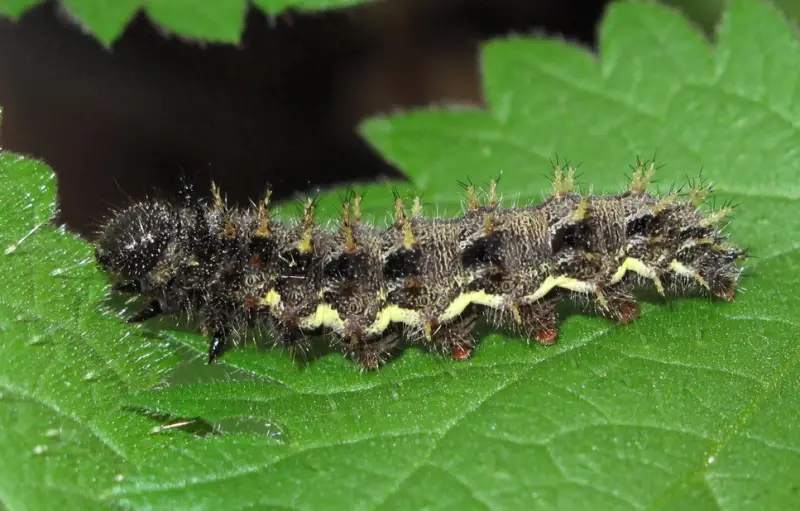
The Red Admiral caterpillar is typically dark brown to black with white spots and numerous spiny projections along its body. It has a slightly arched shape and may show faint yellow striping depending on its stage of development. Growing to about 1.25 inches long, it is often found curled inside a folded leaf.
This caterpillar feeds almost exclusively on nettles, particularly stinging nettle (Urtica dioica), which it uses to construct a protective shelter by folding the leaves with silk. It remains hidden during the day, emerging only to feed. This behavior helps shield it from predators and extreme weather.
In Texas, Red Admiral caterpillars are most commonly found in moist, shaded areas where nettle plants thrive, such as along creeks, forest edges, and gardens. They appear from spring through fall and may have multiple generations each year in the warmer southern regions of the state.
Tawny Emperor Caterpillar (Asterocampa clyton)
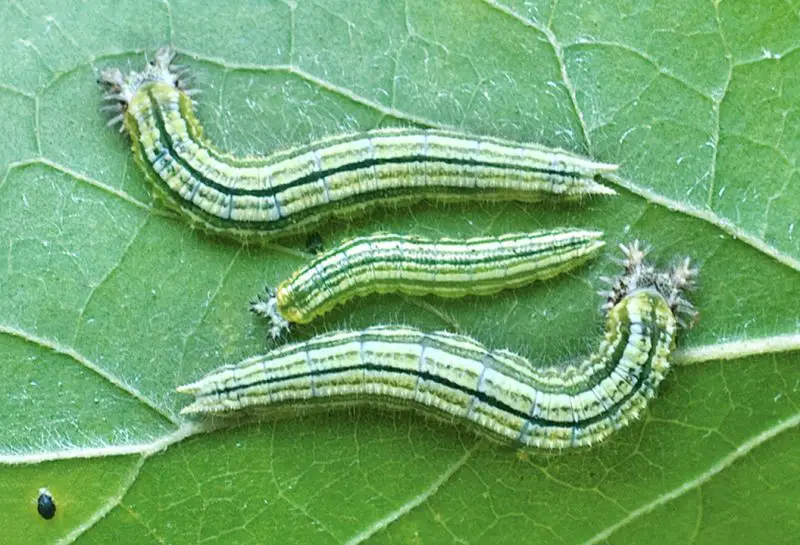
The Tawny Emperor caterpillar is pale green with faint yellowish stripes running lengthwise along its body. Its head is notable for two short, horn-like projections. This caterpillar can grow up to 2 inches long and has a soft, velvety texture that blends well with foliage.
This species feeds primarily on hackberry trees (Celtis spp.), where it often rests on the underside of leaves. The caterpillars are typically gregarious in early instars, later becoming more solitary as they mature. They are known for their relatively calm behavior and lack of defensive features like stinging spines.
In Texas, Tawny Emperor caterpillars are common in wooded areas, parks, and neighborhoods where hackberry trees are present. They are especially prevalent in central and eastern Texas and can be seen from late spring to early fall, depending on local climate conditions.
Hackberry Emperor Caterpillar (Asterocampa celtis)
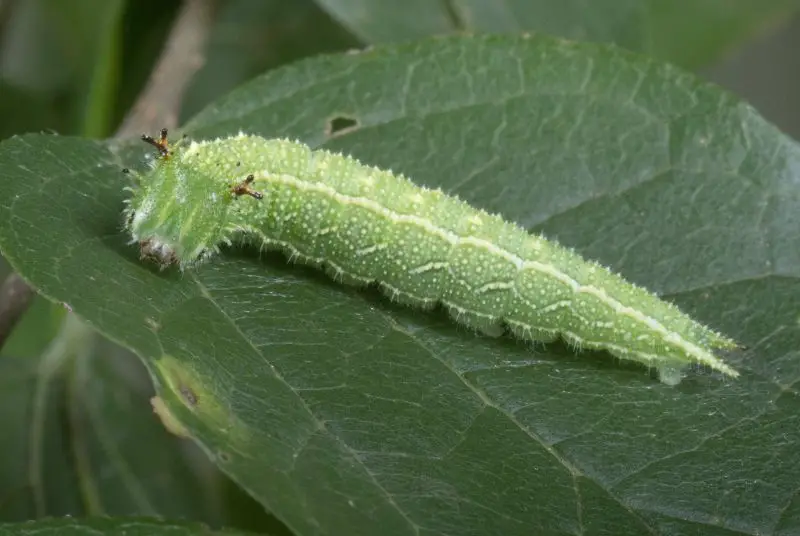
The Hackberry Emperor caterpillar is similar in appearance to the Tawny Emperor but usually displays a brighter green color with more defined white or yellow stripes. It also features a pair of short horns on its head and a forked tail on the rear end. It typically grows to about 1.5 to 2 inches in length.
This species also feeds exclusively on hackberry trees, where it is often found resting along twigs or the midrib of leaves. The caterpillars are not aggressive and are harmless to humans. They go through several molts before forming a green chrysalis with gold flecks.
In Texas, Hackberry Emperors are widespread and frequently encountered wherever hackberry trees are found. They are active from spring through early fall and often seen in both urban and rural settings, including backyards and nature preserves.
American Lady Caterpillar (Vanessa virginiensis)

The American Lady caterpillar is spiny and dark-colored, with distinctive yellow and black striping and rows of white or red dots. Covered in bristly hairs, it can reach about 1.25 inches in length. The caterpillar constructs a silky nest by tying leaves together to form a protected feeding chamber.
This caterpillar feeds primarily on plants in the aster family, such as cudweed, everlasting, and pussytoes. It prefers open sunny areas where these host plants grow abundantly. Despite its intimidating appearance, it is harmless and does not sting or bite.
In Texas, American Lady caterpillars are found statewide, especially in open fields, gardens, and roadside habitats. They are most active during the warmer months and can produce several generations each year. Their compact, leaf-bound shelters make them easy to identify in the wild.
Salt Marsh Moth Caterpillar (Estigmene acrea)
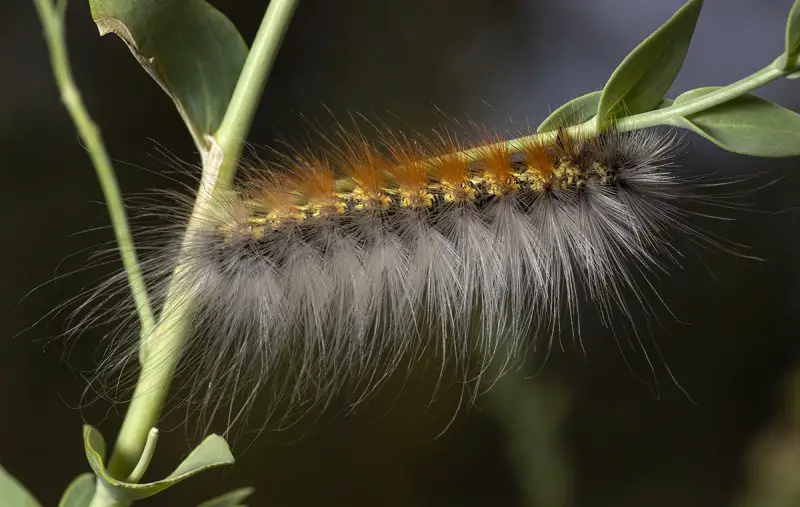
The Salt Marsh Moth caterpillar, often called the “woolly bear,” is a highly variable larva that ranges in color from yellowish to reddish brown to nearly black. It is covered in dense bristly hairs and can grow up to 2 inches long. Despite its hairy appearance, it does not sting, though sensitive individuals may experience mild irritation from the hairs.
This caterpillar is a generalist feeder and consumes the leaves of many plants, including cotton, cabbage, beans, sunflowers, and ornamental flowers. It is often found feeding in open areas like fields and gardens, sometimes in large numbers. Its diverse diet allows it to thrive in many environments.
In Texas, Salt Marsh Moth caterpillars are widely distributed and can be seen from spring through fall. They are especially common in agricultural regions and coastal areas. These caterpillars eventually pupate in cocoons made of silk and hair, transforming into striking white moths with black spots.
Pearl Crescent Caterpillar (Phyciodes tharos)
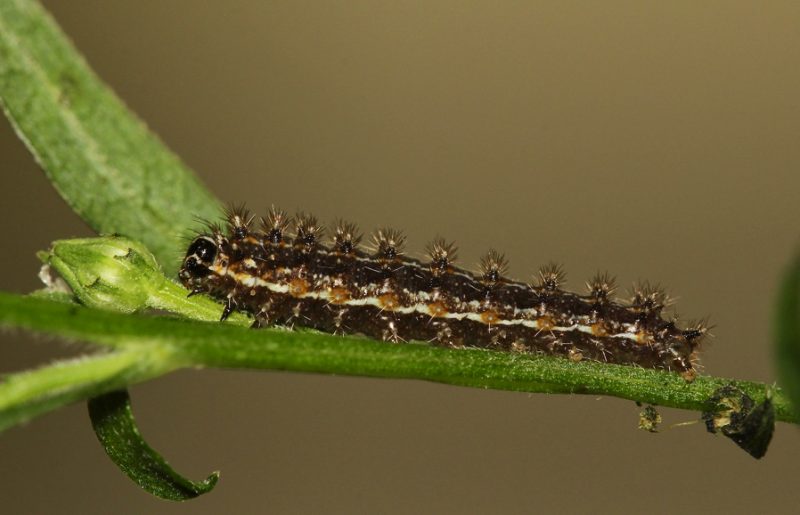
The Pearl Crescent caterpillar is dark gray to black with a row of pale yellow or white dots running down its back and sides. It has spiny projections along its body and can grow up to about 1 inch in length. The surface appears slightly rough, and the caterpillar has a cylindrical shape typical of many brush-footed butterflies.
This species primarily feeds on asters (Symphyotrichum spp.), which are abundant in open fields, prairies, and roadsides. The caterpillars are usually active during the warmer months and may be found curled on the undersides of leaves. They pupate into a brown, jagged chrysalis resembling dried plant material, which aids in camouflage.
In Texas, Pearl Crescent caterpillars are common throughout the state, particularly in sunny, open habitats. They are present from spring to fall and can produce multiple broods per year. Their host plants thrive in disturbed soils, helping the species remain widespread and resilient.
Little Yellow Caterpillar (Eurema lisa)
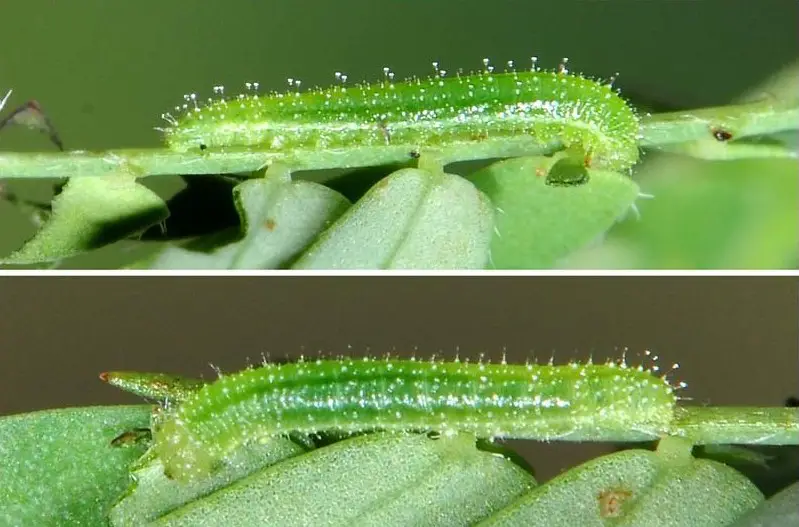
The Little Yellow caterpillar is small, slender, and light green with a faint yellow stripe running along each side. It has a smooth body without noticeable hairs or spines and reaches about 0.8 inches in length. Its camouflage makes it nearly invisible among the leaves it feeds on.
This caterpillar feeds primarily on legumes, especially partridge pea (Chamaecrista fasciculata), which is common in sandy or disturbed soils. The caterpillar tends to rest and feed along the midrib of leaves, blending seamlessly with its host plant. It is quiet in behavior and avoids movement unless disturbed.
In Texas, the Little Yellow caterpillar is found mainly in the eastern and southern regions where its host plants grow in abundance. It appears during spring and summer and may produce several generations annually in warmer climates. The adult butterfly is small and bright yellow, often seen fluttering low in fields and along roadsides.
Orange Sulphur Caterpillar (Colias eurytheme)
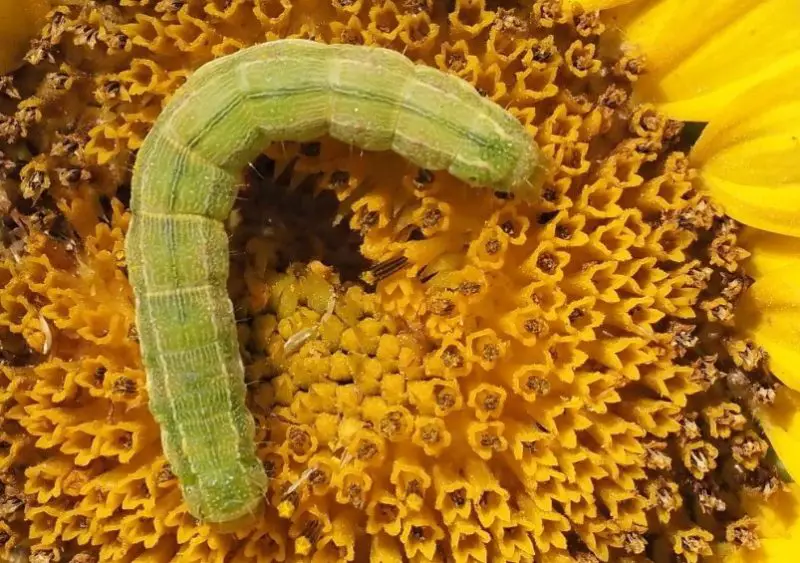
The Orange Sulphur caterpillar is pale green and finely speckled with small black dots. It has a white or yellow stripe along each side and is covered in fine short hairs. Growing up to about 1.2 inches long, it has a plump, smooth appearance and a somewhat tapered rear end.
This caterpillar feeds primarily on legumes such as alfalfa, clovers, and vetches. It is often found in agricultural fields, meadows, and pastures. The caterpillar is mostly active at night or during cool, overcast days, hiding on the underside of leaves during hotter periods.
In Texas, Orange Sulphur caterpillars are widespread and especially common in the central and eastern parts of the state. They are active from spring through late fall and often have overlapping generations. The adult butterflies are fast flyers and are often seen in large numbers in open grassy areas.
Checkered White Caterpillar (Pontia protodice)
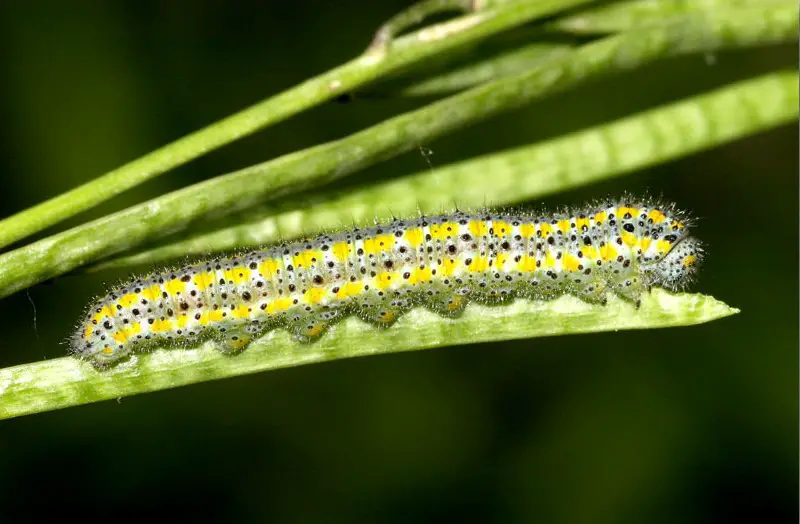
The Checkered White caterpillar is green to bluish-green with thin yellow stripes running longitudinally along its body. It is covered with fine white hairs and can grow to about 1 inch long. Its coloration allows it to blend well with the cruciferous plants it feeds on.
It feeds mainly on plants in the mustard family, including wild mustards, peppergrasses, and cultivated brassicas like cabbage and broccoli. The caterpillars feed both day and night and may defoliate host plants when present in high numbers. They often pupate on or near their host plant, creating a loosely attached, angular chrysalis.
In Texas, Checkered White caterpillars are found in dry, open fields, farmlands, and roadsides across much of the state. They are active from spring through fall, especially in areas where wild mustards grow. Their adaptability to disturbed areas has helped maintain their presence even in suburban landscapes.
Question Mark Caterpillar (Polygonia interrogationis)
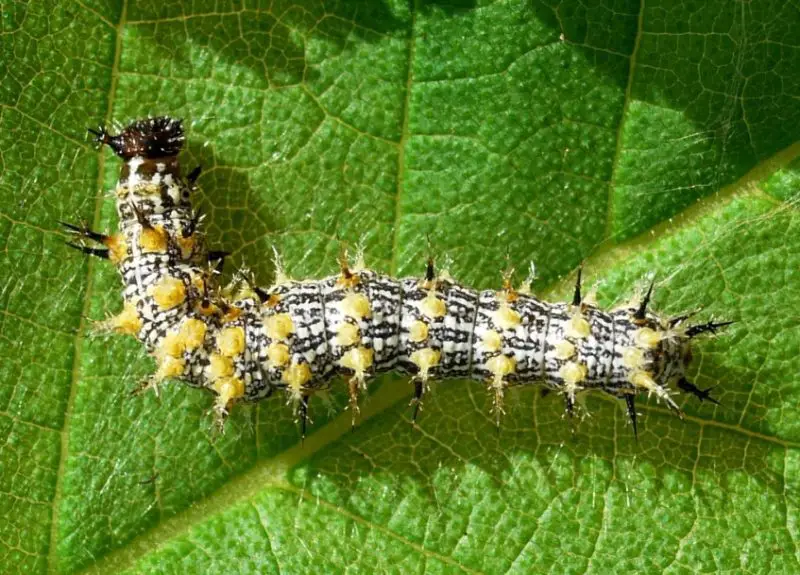
The Question Mark caterpillar is spiny and dark in color, typically brown to nearly black with white, orange, or yellow markings along its back and sides. It features several rows of branched spines and grows up to 1.5 inches long. Its appearance can be intimidating, though it is harmless to humans.
This caterpillar feeds on a wide range of plants, including elms, nettles, hackberries, and false nettle. It is often found on the underside of leaves or along the stems. The caterpillar tends to be solitary and has a strong preference for wooded edges, forest understories, and urban greenbelts.
In Texas, Question Mark caterpillars are most common in the eastern and central regions, where their host trees and shrubs are more prevalent. They are seen from late spring through early fall and can produce two to three broods per year. The adult butterfly is known for its angular wings and the silver comma-shaped mark on the underside of the hindwing.
Southern Flannel Moth Caterpillar (Megalopyge opercularis)
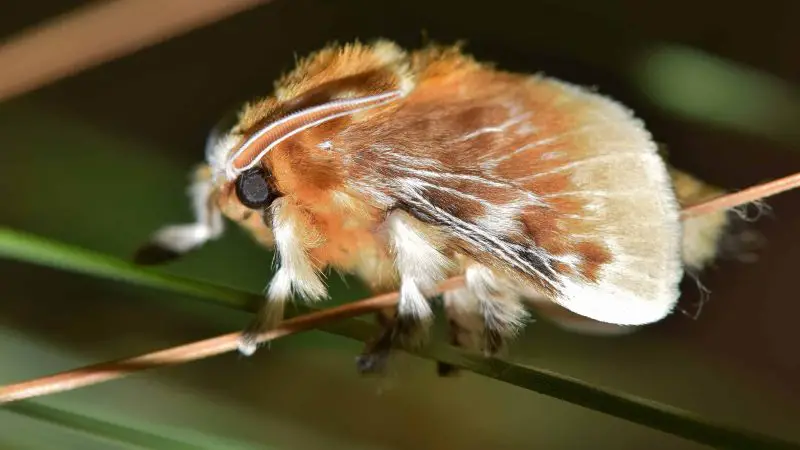
The Southern Flannel Moth caterpillar, also known as the puss caterpillar, is one of the most distinctive and dangerous caterpillars in Texas. It appears fluffy and soft with a dense coat of hair-like setae that can range from golden brown to grayish-white. Beneath its deceptively soft appearance are venomous spines capable of delivering a painful sting. The caterpillar typically measures around 1 inch long.
This caterpillar feeds on a wide variety of trees and shrubs, including oak, elm, pecan, and citrus. It is often found on the underside of leaves or on tree trunks, where it rests during the day. The venomous spines can cause intense burning pain, swelling, nausea, and sometimes more severe reactions in sensitive individuals, making this species one to avoid.
In Texas, the Southern Flannel Moth caterpillar is found primarily in the eastern and southern regions, especially during late summer and fall. It prefers warm, humid environments and wooded areas where its host plants grow. Despite its harmful sting, it develops into a small, fuzzy moth that is not considered dangerous in its adult form.
Dainty Sulphur Caterpillar (Nathalis iole)

The Dainty Sulphur caterpillar is slender and light green with faint longitudinal stripes and fine, short hairs. It grows up to about 0.8 inches long and is relatively inconspicuous due to its smooth body and subtle coloring. Its body shape is narrow and slightly flattened, helping it hide on the midrib of leaves.
It feeds primarily on low-growing plants in the Asteraceae family, particularly Spanish needles (Bidens spp.) and other composites found in disturbed areas. The caterpillar is active during warmer months and completes its development quickly in warm climates, often producing multiple generations in a single season.
In Texas, the Dainty Sulphur is widely distributed throughout the state but is especially common in the southern and central regions. It thrives in sunny, open spaces such as roadsides, pastures, and gardens. This butterfly species is the smallest North American sulphur, and its small, yellow-winged adult form can often be seen fluttering close to the ground.
Fiery Skipper Caterpillar (Hylephila phyleus)
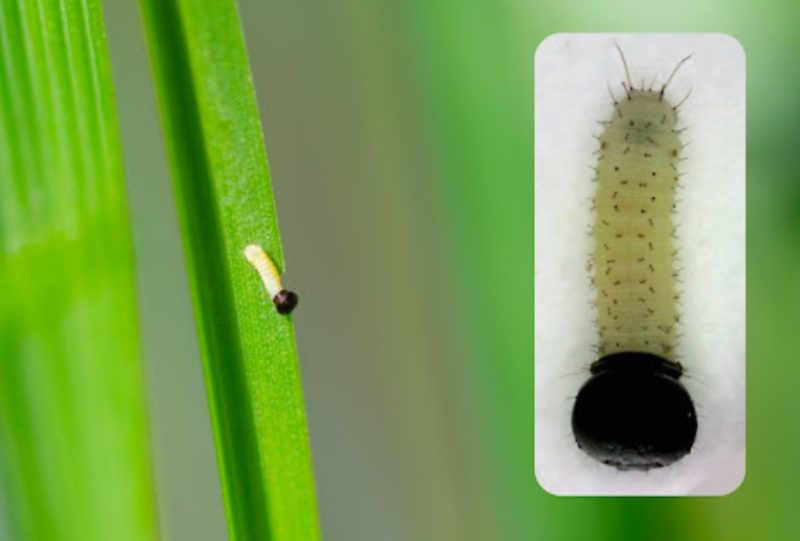
The Fiery Skipper caterpillar is greenish to brown with a dark head capsule and faint stripes running along its body. It grows up to about 1 inch long and has a slightly wrinkled appearance. It builds a protective shelter by tying grass blades together with silk, where it hides during the day.
This caterpillar feeds on various grasses, including Bermuda grass and crabgrass, which makes it a common pest in lawns and golf courses. It is mostly nocturnal in its feeding habits, emerging at night to graze on the blades and returning to its shelter before sunrise.
In Texas, Fiery Skipper caterpillars are found across the state, especially in urban, suburban, and open grassy areas. They are most active from spring through fall and can produce several generations per year in warmer climates. The adult butterfly is orange with dark brown borders and is a fast, darting flier often seen hovering around flowers and grassy areas.
Green Cloverworm Caterpillar (Hypena scabra)
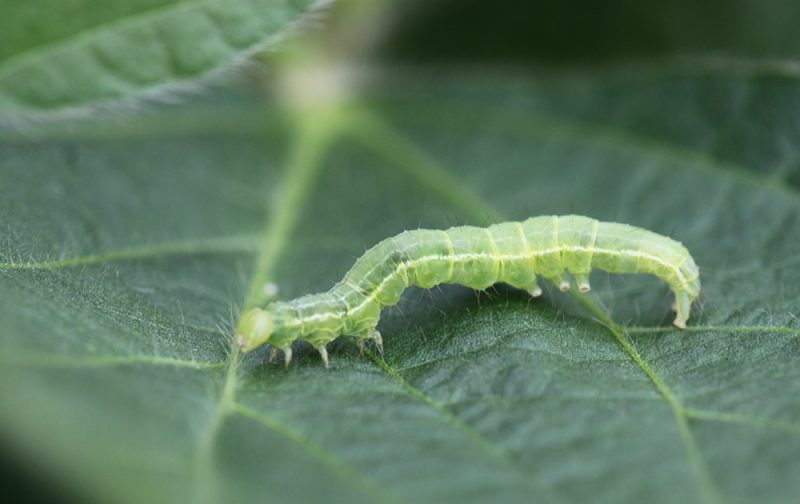
The Green Cloverworm caterpillar is slender, pale green, and features multiple thin white stripes running longitudinally along its body. It is soft-bodied, hairless, and grows up to 1.2 inches long. The caterpillar moves in a looping fashion, which can help distinguish it from other green caterpillars.
It feeds on a wide range of legumes, particularly alfalfa, soybeans, and clover, and can occasionally be a pest in agricultural fields. Green Cloverworms feed both during the day and at night and may appear in large numbers under favorable conditions. When disturbed, they often drop from leaves on a silken thread.
In Texas, this species is widespread and particularly common in the eastern and central parts of the state. It is active from late spring through fall and may have several generations annually. The adult moth is brown and unremarkable, often resting with its wings tent-like over the body.
Yellow-striped Armyworm (Spodoptera ornithogalli)
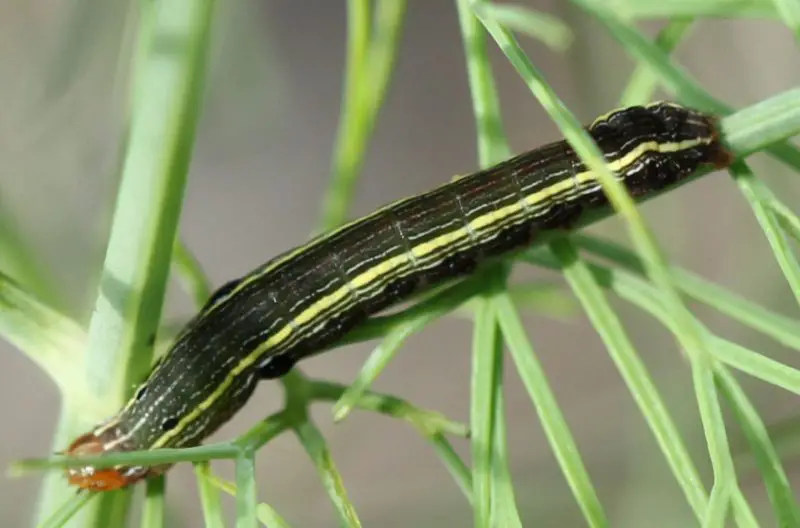
The Yellow-striped Armyworm is a dark brown to black caterpillar with bold yellow stripes running along its sides. It also features small dark spots and a light-colored inverted “Y” shape on the head. It grows up to 1.5 inches long and has a smooth, cylindrical body covered in fine hairs.
This caterpillar feeds on a wide variety of host plants, including vegetables, field crops, and ornamentals, making it a frequent agricultural pest. It often feeds in groups during early stages, giving rise to the name “armyworm.” As it matures, it becomes solitary and hides in soil or debris during the day.
In Texas, the Yellow-striped Armyworm is commonly found throughout the state, especially in agricultural areas and gardens. It is most active from late spring through fall and can cause significant damage during outbreaks. The adult moth is a nocturnal flier, mottled brown in color, and lays clusters of eggs on host plants.
Ailanthus Webworm Caterpillar (Atteva aurea)
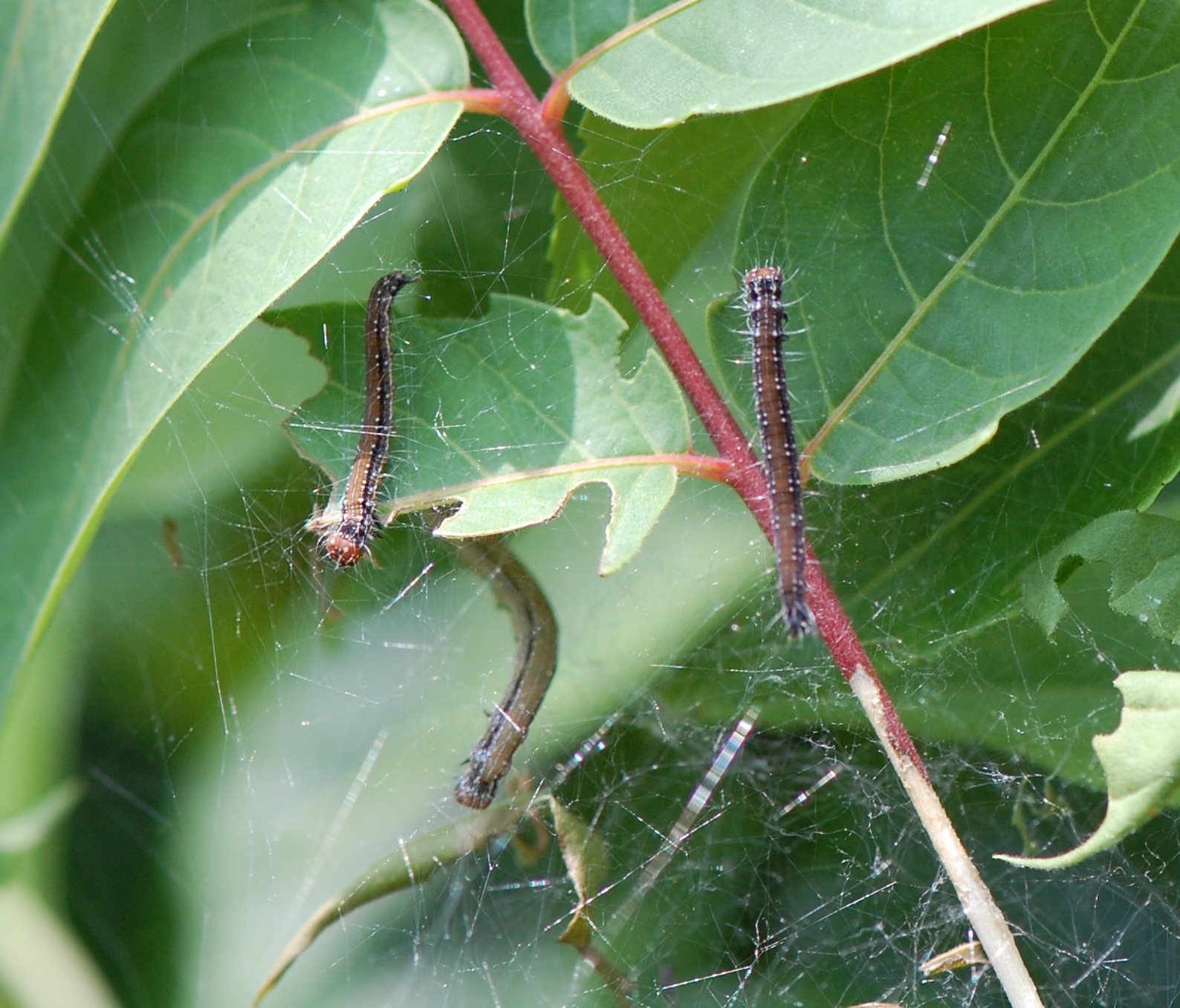
The Ailanthus Webworm caterpillar is slender and pale with a dark head and fine hairs. Its body is cream-colored with faint brown markings, which help it blend in with tree bark and foliage. It typically grows to about 0.8 to 1 inch long. The larvae are not especially striking in appearance but are recognizable when seen in large numbers within their characteristic silk webs.
This species primarily feeds on the Tree-of-Heaven (Ailanthus altissima), an invasive plant in many parts of the United States. The caterpillars spin dense communal silk nests in the tree’s leaves or bark crevices, where they live and feed together. They are active during the warmer months and may produce several broods per year in warmer climates.
In Texas, Ailanthus Webworm caterpillars are found wherever Tree-of-Heaven grows, particularly in urban and suburban areas. Although they may seem harmful due to their numbers, they rarely pose a serious threat to healthy trees. The adult moth is small and vividly patterned with orange, black, and white, often mistaken for a beetle at first glance.
American Snout Caterpillar (Libytheana carinenta)

The American Snout caterpillar is greenish to brown and relatively plain, with faint longitudinal lines and a small dark head. It typically measures about 1 to 1.2 inches in length and may have fine, scattered hairs along its body. Its cryptic appearance helps it blend into foliage, making it hard to spot on host plants.
This caterpillar feeds almost exclusively on hackberry trees (Celtis species), where it hides among the leaves during the day. After hatching, larvae feed steadily until they pupate, often causing temporary defoliation during population booms. The caterpillar plays a key role in the lifecycle of the American Snout butterfly, known for its long “snout” formed by extended labial palps.
In Texas, the American Snout caterpillar is widespread, especially in central and southern parts of the state where hackberry trees are abundant. It’s particularly common after rains following droughts, when population explosions can lead to mass migrations of the adult butterflies.
Ceraunus Blue Caterpillar (Hemiargus ceraunus)

The Ceraunus Blue caterpillar is tiny, flattened, and slug-like in appearance, often pale green to yellowish with faint lines and a smooth surface. Measuring only about 0.4 to 0.6 inches when fully grown, these caterpillars are extremely small and easy to overlook. They have a subtle, matte texture and may show hints of pink or purple depending on their diet.
They primarily feed on legumes such as alfalfa, clover, and mesquite, usually targeting flower buds and developing seed pods. This species has a mutualistic relationship with ants, which protect the caterpillar in exchange for sugary secretions from specialized glands. The larvae typically remain hidden within flower clusters.
In Texas, Ceraunus Blue caterpillars are found throughout the state in fields, meadows, and gardens where their host plants are present. They are most active in spring and fall. The adult butterfly is a delicate blue with eye-catching markings and can often be seen fluttering low to the ground in open sunny areas.
Banded Sphinx Caterpillar (Eumorpha fasciatus)

The Banded Sphinx caterpillar is strikingly colorful, with green or reddish body forms marked by black and yellow longitudinal stripes. It can reach up to 3 inches in length and has a curved horn at the rear, typical of sphinx moth larvae. Its bold coloration serves as a warning to potential predators.
This caterpillar feeds primarily on plants in the Onagraceae family, such as evening primrose and water primrose. It is known for its strong appetite and can defoliate host plants rapidly. The caterpillar is active during both day and night and may appear in large numbers during warm, wet seasons.
In Texas, the Banded Sphinx caterpillar is found mainly in the eastern and southeastern parts of the state. It prefers wetland edges, ditches, and riparian zones where its host plants thrive. The adult moth is large and beautifully patterned with pink and olive tones and is often attracted to lights at night.
White-lined Sphinx Caterpillar (Hyles lineata)

The White-lined Sphinx caterpillar varies greatly in color, ranging from bright green to black, with longitudinal yellow or white stripes and orange spots along the sides. It grows up to 3.5 inches long and bears a curved tail horn at the rear, typical of hornworms. Some color morphs are highly vibrant, while others are more muted.
It feeds on a wide array of plants, including purslane, evening primrose, grapevine, and even garden crops. During outbreaks, large numbers of caterpillars may migrate in search of food, stripping plants bare along their path. Despite their voracious feeding, they are generally not considered long-term pests.
In Texas, White-lined Sphinx caterpillars are found statewide and are most active in late spring through fall, especially after rainy periods. They are often seen in desert regions, grasslands, and gardens. The adult moth is a strong flier resembling a hummingbird, known for its rapid wingbeats and ability to hover while feeding on nectar.
Goatweed Leafwing Caterpillar (Anaea andria)
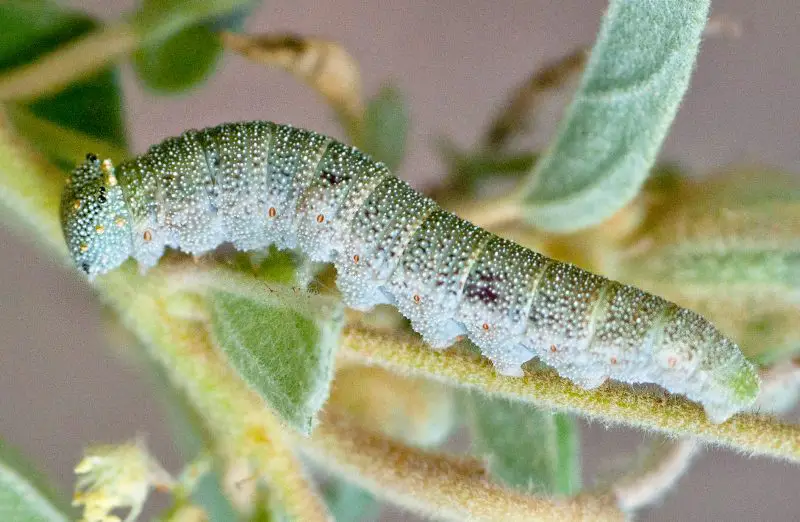
The Goatweed Leafwing caterpillar is typically green or brown with a slightly rough texture, helping it blend in with its leafy surroundings. It grows up to about 1.5 inches long and has small bumps and tiny spines along its body. The caterpillar’s coloring and shape closely mimic the leaves it feeds on, providing excellent camouflage against predators.
This species feeds primarily on goatweed (Croton species), which is abundant in parts of Texas. The caterpillar rests on the underside of leaves and feeds during the night, making it less conspicuous during daylight hours. It constructs no silk shelters but relies heavily on its cryptic appearance for protection.
In Texas, the Goatweed Leafwing caterpillar is mainly found in central and southern regions where its host plants grow. The adult butterfly is known for its striking leaf-shaped wings with intricate brown and orange patterns, making it a favorite among butterfly watchers.
Horace’s Duskywing Caterpillar (Erynnis horatius)

Horace’s Duskywing caterpillar is small and dark green or brown, often with faint white or yellow stripes along its sides. It reaches about 1 inch in length and has a rough, somewhat spiky texture. This cryptic appearance helps it blend with the stems and leaves of its host plants, avoiding detection by predators.
This caterpillar primarily feeds on various legumes such as black locust and redbud, where it eats leaves and sometimes young shoots. It tends to feed openly during the day but stays close to the plant’s stems and concealed areas to stay protected.
In Texas, Horace’s Duskywing caterpillar is widespread but is especially common in central and eastern parts of the state. The adult butterfly is dark brown with subtle white spots and rapid flight, commonly found near woodlands and open fields where the caterpillars develop.
Southern Dogface Caterpillar (Zerene cesonia)

The Southern Dogface caterpillar is smooth-bodied and usually bright green with thin white or yellow stripes running lengthwise. It grows up to about 1.5 inches long and has a slightly tapered body with a small head. Its coloration allows it to blend well with the foliage of its host plants.
It feeds mostly on species of the pea family, especially leadplant and related legumes. The caterpillar is active during the day and night but often hides under leaves when resting. It consumes the foliage steadily until pupation.
In Texas, Southern Dogface caterpillars are primarily found in southern and central regions, favoring dry, open habitats such as prairies and scrublands. The adult butterfly is named for the distinct dog-face pattern on the upper surface of its yellow wings, making it easily recognizable.
Forest Tent Caterpillar (Malacosoma disstria)
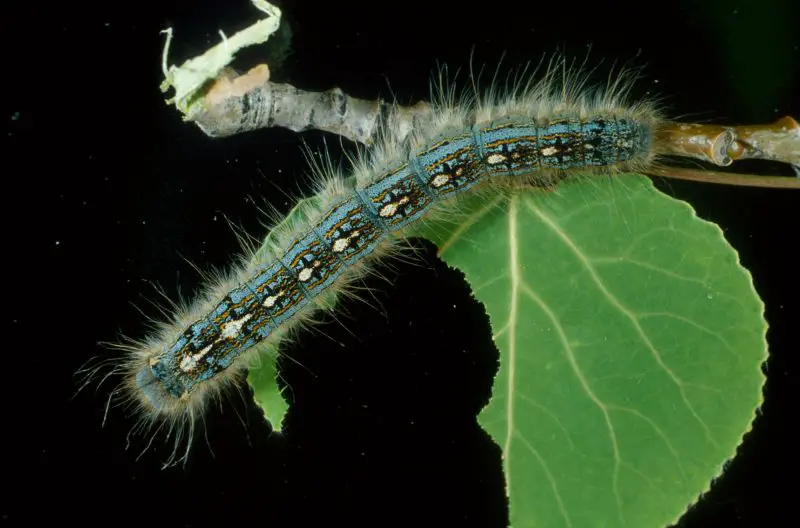
The Forest Tent Caterpillar is a pale blue to gray caterpillar with a series of distinct keyhole-shaped white spots down its back. It grows up to 2 inches long and is covered with short, fine hairs. Unlike other tent caterpillars, it does not build large communal tents but creates silk mats on tree trunks and branches.
This species feeds on a wide variety of hardwood trees, including oak, maple, and aspen. It often forms large populations that can defoliate entire trees during outbreak years. The caterpillars are active during spring and early summer and feed primarily during the day.
In Texas, Forest Tent Caterpillars are mostly found in the eastern and northeastern parts where forests are dense. They play an important ecological role but may be considered pests in managed woodlands and urban areas during population surges. The adult moth is tan with darker brown markings and is active mainly at night.
Rosy Maple Moth Caterpillar (Dryocampa rubicunda)
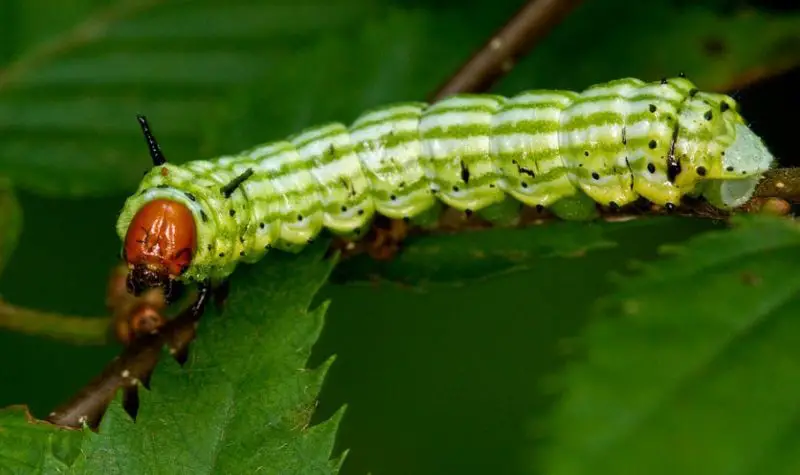
The Rosy Maple Moth caterpillar is bright green with distinctive white and yellow stripes running lengthwise along its body. It grows up to about 2 inches in length and has a smooth, soft texture. When disturbed, it curls into a tight spiral as a defensive posture.
This caterpillar feeds primarily on the leaves of maple trees, especially red and silver maples, causing moderate defoliation in some areas. It feeds mostly at night and hides under leaves or bark during the day to avoid predators.
In Texas, Rosy Maple Moth caterpillars are found mainly in the eastern parts where maples are common. The adult moth is famous for its striking pink and yellow coloration, resembling a delicate pastel-colored flower, and is often seen fluttering near wooded areas at dusk.
Reakirt’s Blue Caterpillar (Echinargus isola)
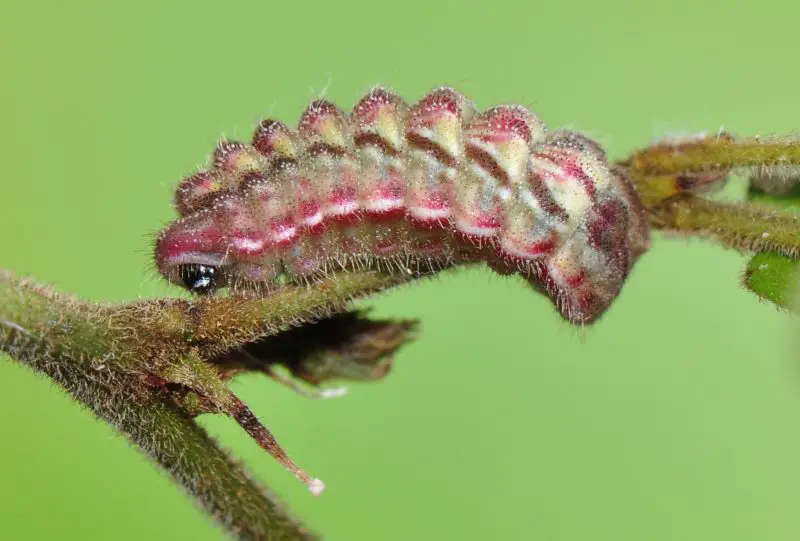
The Reakirt’s Blue caterpillar is small and slender, typically green with faint, lighter stripes running along its body. It reaches about 0.5 to 0.7 inches in length and has a smooth texture. Its coloration helps it blend in with the flowers and leaves of its host plants, making it difficult to spot.
This caterpillar primarily feeds on various legumes and low-growing plants such as tick-trefoil and wild beans. It is often found on flower heads where it feeds on buds and blossoms. The larvae have a symbiotic relationship with ants, which tend and protect them in exchange for sugary secretions.
In Texas, Reakirt’s Blue caterpillars are common in open fields and meadows across the state, especially where wildflowers grow abundantly. The adult butterfly is a delicate blue with a subtle pattern of white and black spots on the wings, frequently seen in sunny, open habitats.
Io Moth Caterpillar (Automeris io)
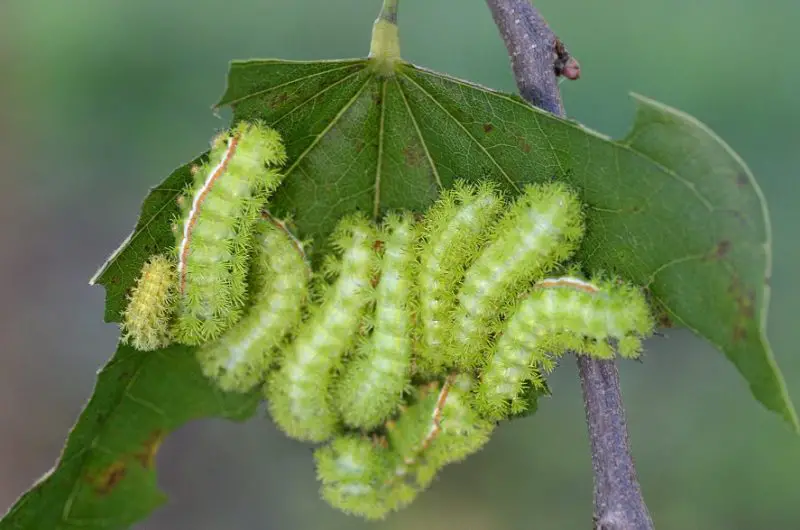
The Io Moth caterpillar is bright green and covered in clusters of venomous spines that cause painful stings when touched. It can grow up to 2.5 inches long and has white and yellow stripes running laterally along its body. Its striking appearance warns predators of its toxicity.
This species feeds on a wide range of trees and shrubs, including willows, maples, and hackberries. The caterpillar feeds openly on leaves and is often found in groups during early instar stages. Its venomous spines provide an effective defense against birds and other predators.
In Texas, the Io Moth caterpillar is widespread, especially in woodlands and suburban areas throughout the state. The adult moth is notable for its large size and eye-like spots on its hind wings, which serve to startle predators when exposed.
Cecropia Moth Caterpillar (Hyalophora cecropia)
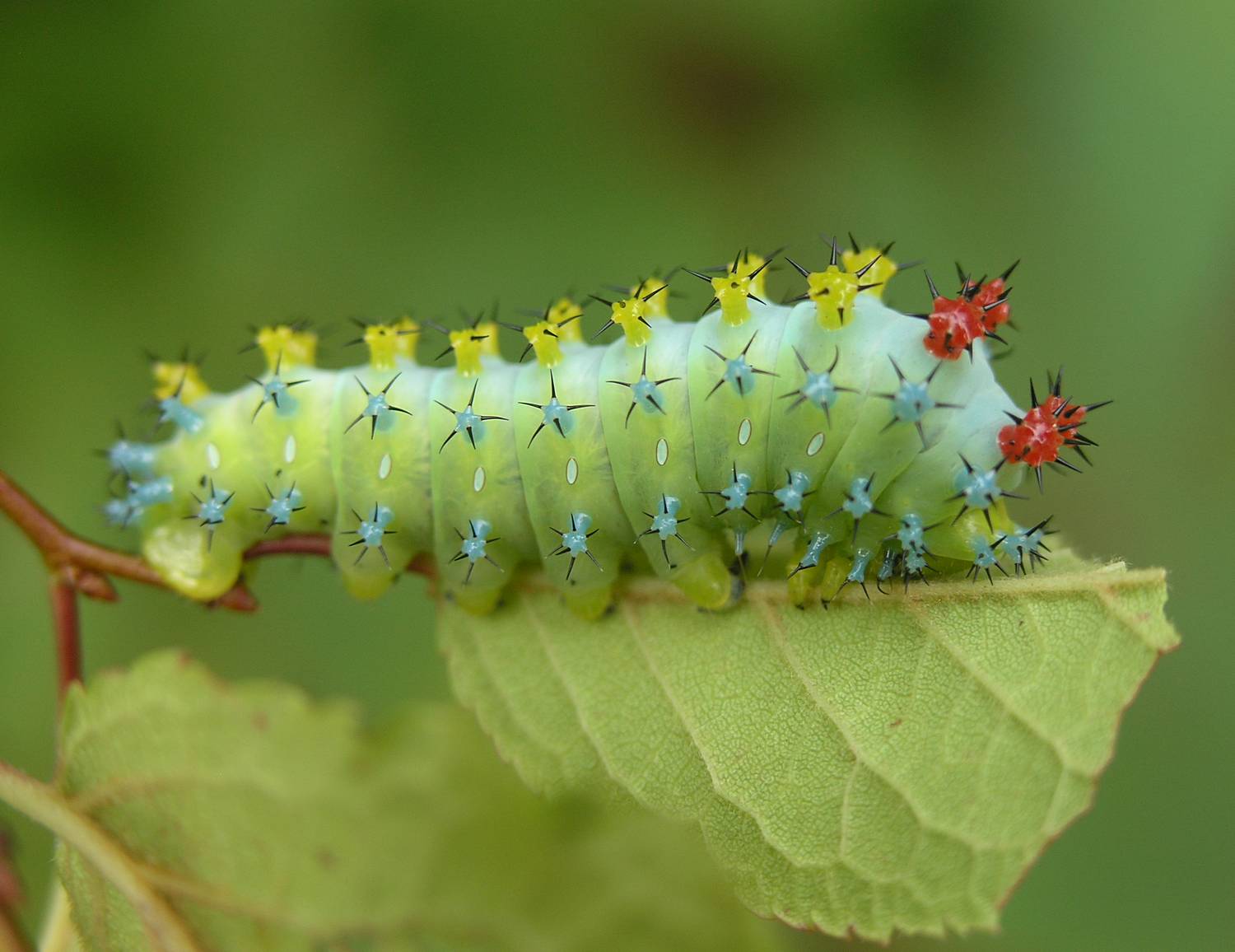
The Cecropia Moth caterpillar is large and impressive, growing up to 4 to 5 inches long. It has a pale green body adorned with blue, orange, and yellow tubercles that give it a spiky appearance, though it is harmless to humans. Its vibrant colors serve as a warning to potential predators.
This caterpillar feeds on a variety of trees such as maples, cherries, and birches. It consumes large quantities of leaves as it grows rapidly in late spring and early summer. Despite its intimidating appearance, the caterpillar is gentle and slow-moving.
In Texas, Cecropia Moth caterpillars are primarily found in eastern and central parts of the state where host trees are abundant. The adult moth is the largest native moth in North America, with striking reddish-brown wings featuring crescent-shaped white markings.
Hickory Horned Devil (Citheronia regalis)

The Hickory Horned Devil is one of the largest and most striking caterpillars found in Texas, reaching lengths up to 6 inches. It has a bright green body with long, curved, reddish-black spines on its thorax that resemble horns. Despite its fierce appearance, it is completely harmless to humans.
This caterpillar feeds mainly on hickory, walnut, and sweetgum trees. It consumes leaves voraciously during late summer, growing quickly before pupating underground. It is mostly solitary and can be spotted resting on tree trunks or branches during the day.
In Texas, Hickory Horned Devils are found mostly in eastern forests and woodlands. The adult moth, known as the Regal Moth, is large and impressive, with yellow-orange wings adorned with black and white spots.
Tersa Sphinx Caterpillar (Xylophanes tersa)

The Tersa Sphinx caterpillar varies in color from bright green to brown, often with eye-like spots near its head that help deter predators. It can grow up to 3 inches long and has a smooth, slightly tapered body with a small horn at the rear.
It primarily feeds on plants in the Rubiaceae and Malvaceae families, including coffee and hibiscus. The caterpillar is a strong feeder and is most active at night, hiding during the day among leaves or branches to avoid detection.
In Texas, Tersa Sphinx caterpillars are found mostly in the southern regions where warmer climates and host plants are prevalent. The adult moth is sleek and fast-flying, with olive green and brown tones and narrow wings designed for rapid flight.
Giant Leopard Moth Caterpillar (Hypercompe scribonia)
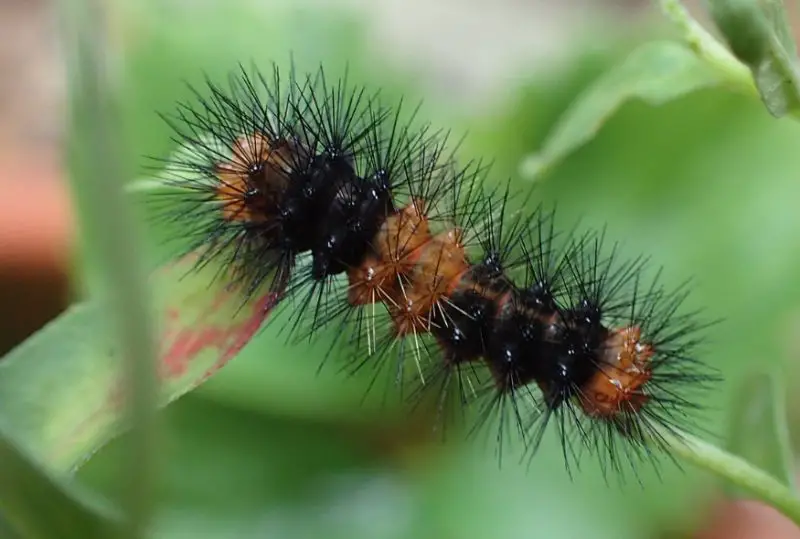
The Giant Leopard Moth caterpillar is a striking black, fuzzy caterpillar covered in dense bristles that give it a woolly appearance. It can grow up to 3 inches long, and when disturbed, it often curls into a tight ball for protection. The dense hair helps deter predators, although it is harmless to humans.
This caterpillar feeds mainly on a wide variety of broadleaf plants, including dandelions, violets, and plantains. It is a generalist feeder and can be found crawling on low vegetation in gardens, fields, and woodland edges. The larva is nocturnal, feeding mostly at night and hiding during the day.
In Texas, the Giant Leopard Moth caterpillar is found throughout the state, especially in warmer and humid areas. The adult moth is large and white with striking black spots, resembling a leopard’s pattern, which makes it very distinctive and popular among moth enthusiasts.
Saddleback Caterpillar (Acharia stimulea)

The Saddleback Caterpillar is easily recognized by its unique saddle-shaped bright green patch in the center of its brownish body, surrounded by a bright white border. It is small, about 1 inch long, and covered in venomous spines that cause a painful sting if touched, serving as a strong defense mechanism.
This caterpillar feeds on a variety of deciduous trees and shrubs, including oak, maple, and elm. It tends to stay on the underside of leaves, feeding during the day and blending in with the foliage. The venomous spines help protect it from birds and other predators.
In Texas, the Saddleback Caterpillar is commonly found in forests and suburban areas throughout the state. The adult moth is small and inconspicuous, with yellowish or brownish wings, making the caterpillar stage more notable for its bold warning coloration and defensive traits.
Spiny Oak-Slug Caterpillar (Euclea delphinii)
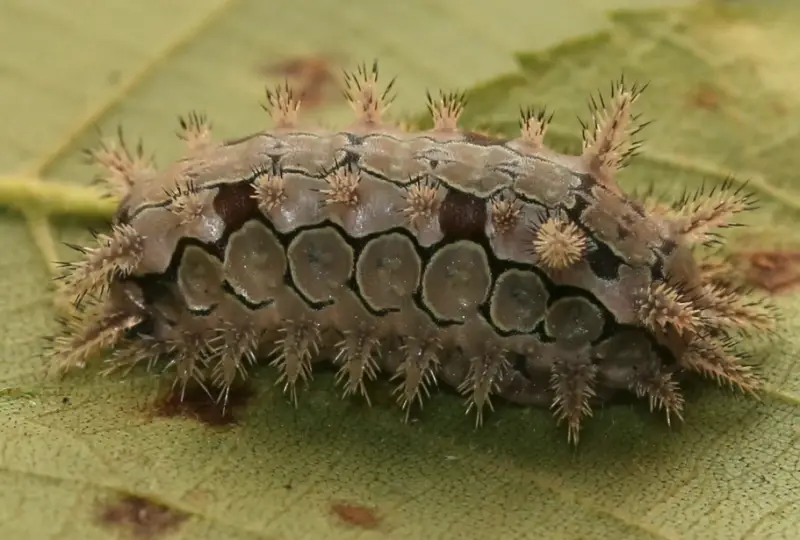
The Spiny Oak-Slug caterpillar is a small, slug-like larva covered with bright green, yellow, and brown spines that resemble a miniature hedgehog. It grows up to 1 inch long and its spines can deliver a mild sting, causing skin irritation in sensitive individuals.
It feeds primarily on oak leaves but can also be found on other hardwood trees such as hickory and walnut. The caterpillar moves slowly and often remains motionless to avoid detection, relying on its spiny appearance as a deterrent to predators.
In Texas, Spiny Oak-Slug caterpillars are mostly found in eastern and central regions where hardwood forests are prevalent. The adult moth is small and yellowish, with less conspicuous markings compared to the dramatic larval stage.
Imperial Moth Caterpillar (Eacles imperialis)
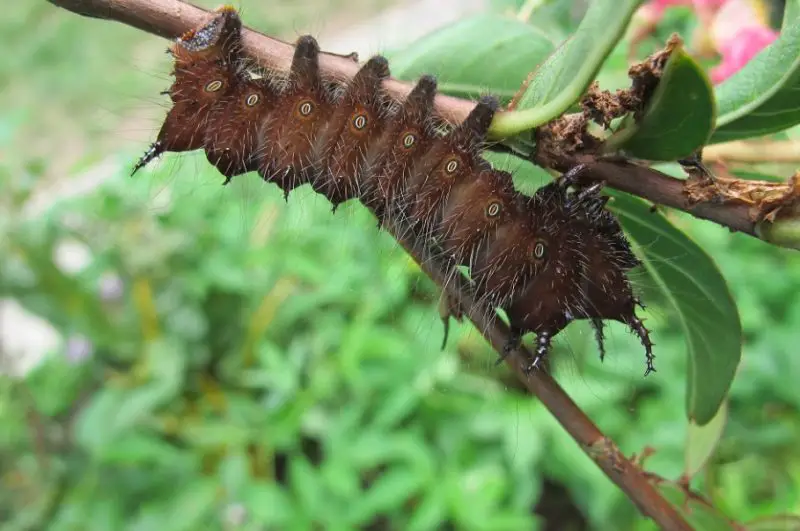
The Imperial Moth caterpillar is a large, impressive larva, usually green or yellow-green with red or orange bumps along its back. It can grow up to 5 inches long, and its stout body is covered with short bristles. The bright bumps serve as a warning to predators.
This caterpillar feeds on a wide range of hardwood trees such as pine, sweetgum, and maples. It is a voracious eater during late summer and early fall, consuming large amounts of foliage as it prepares to pupate. The caterpillar is mostly active at night.
In Texas, Imperial Moth caterpillars are found mainly in the eastern and southeastern parts of the state. The adult moth is large and spectacular, with yellow wings featuring purple spots and a distinctive wing shape, making it one of the most eye-catching moths in the region.
Sleepy Orange Caterpillar (Eurema nicippe)

The Sleepy Orange caterpillar is small and green with fine white stripes running lengthwise along its body. It reaches about 1 inch in length and has a smooth texture. Its coloration helps it camouflage effectively on its host plants.
This species feeds primarily on various species of legumes, including Cassia and Senna plants. The caterpillar often rests on the underside of leaves during the day and feeds mostly at night to avoid predators.
In Texas, Sleepy Orange caterpillars are most common in the southern and coastal regions where their host plants thrive. The adult butterfly is bright orange with black markings, known for its fast and erratic flight pattern.
Clouded Skipper Caterpillar (Lerema accius)
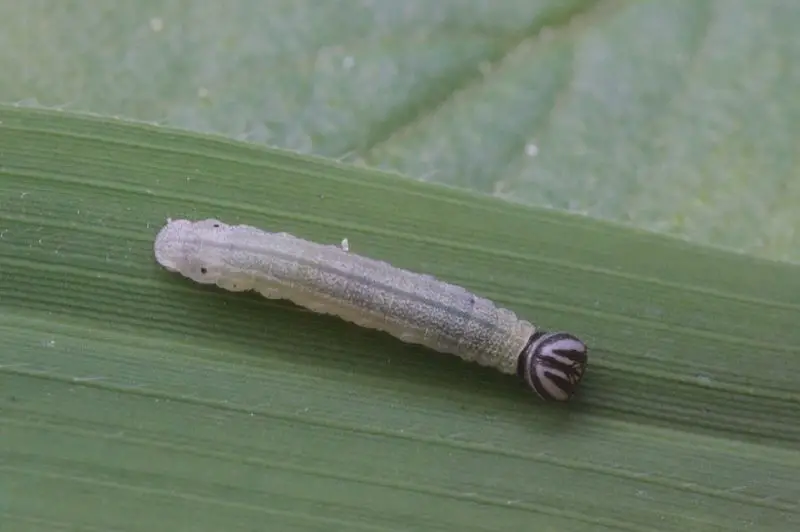
The Clouded Skipper caterpillar is small and usually green with faint, darker stripes along its body, measuring up to 1 inch in length. It has a smooth body and is known for its tendency to construct leaf shelters by folding or rolling leaves together with silk.
This caterpillar feeds primarily on grasses and legumes, including broomsedge and other native plants. The leaf shelters provide protection from predators and environmental conditions while it feeds and develops.
In Texas, Clouded Skipper caterpillars are widespread, particularly in grasslands, prairies, and open fields across the state. The adult butterfly is brown with orange patches and a rapid flight style, often seen in sunny areas.
Bordered Patch Caterpillar (Chlosyne lacinia)
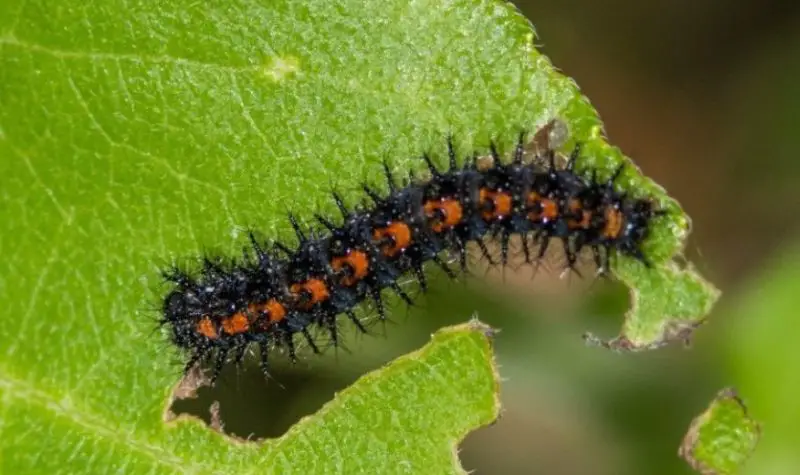
The Bordered Patch caterpillar is dark with a rough texture and covered in small spines, often black or brown with lighter markings. It grows up to 1.5 inches long and its coloration provides camouflage on the host plants.
This caterpillar feeds mainly on sunflowers and related species in the Asteraceae family. It is active during the day and night, frequently feeding openly but sometimes hiding within leaf clusters.
In Texas, the Bordered Patch caterpillar is found throughout most of the state, especially in open fields, roadsides, and disturbed habitats where its host plants are common. The adult butterfly is orange and black with distinctive white spots along the wing edges.

